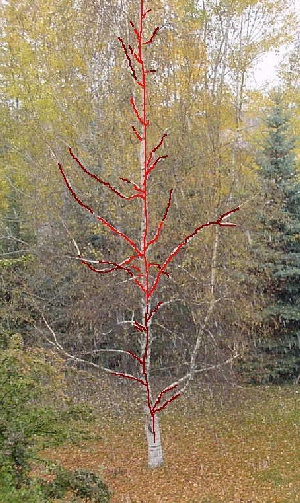9. A Canopy Effect
I was still helping the friend with his pole building near Kendrick, Idaho, and early on the morning of October 12 I set out toward the work site in my pickup. About half way between Pullman and Moscow, my eye happened to catch the tip of a pine tree, which felt a bit out of the ordinary. Looking more attentively, I noted that within the tops of all the living trees, was a concentration of sheng qi . Depending on the tree, the depth of penetration was from a few inches to slightly more than a foot. This was true for the entire trip to Kendrick.
Two days later the penetration of the sheng qi from the top was roughly three times as far. There was no penetration into dead trees, telephone poles, or other non-living vertical objects. Furthermore, the sheng qi did not seem to be entering the tips of the horizontal limbs or branches, just the one highest vertical one.
By the following day, October 15, the sheng qi penetration was twice as far again. It was now more then a fifth of the height of most of the trees.
On the 17th it was roughly a third of the way down.
On the 21st, on a trip up to Spokane, I found that the sheng qi had penetrated about 45% of the tree trunks. There was some penetration back from these parts of the trunks into the branches. But not originating from the extremities, only from the trunks.I was curious to see whether this phenomenon was occurring outside the area covered by the sheng canopy . On the 23rd I travelled to the west. Reaching the edge of the covered area, I observed that there was still sheng qi in the trees. Continuing west, I observed that the depth of penetration gradually diminished, until after a couple miles, there was none. Evidently, the phenomenon was a consequence of the sheng canopy .
On several trips to Seattle over the previous year, I had observed a strong latent vortex on a mountain in the central part of Washington State. This trip brought me close to that mountain, so I decided to treat the vortex while in the neighborhood. There was steep sandy terrain, and the jeep I was driving came near to getting stuck, so I had to retrace my route, and travel an additional 30 miles to reach the vortex from the other side of the mountain. After opening the vortex, being temporarily at a high vantage point, I looked around for other vortices. I became aware of a strong emanation of sha qi far to the southwest towards the Columbia River. This was later to lead to an interesting discovery.
Three days later sheng qi at home had reached 50% of the way down the trees.
Six days later, the sheng canopy had extended about a third of the way to the newly opened vortex, and at home sheng qi reached two thirds of the way down the trees.Below is a photograph of a birch tree, taken on October 31. I have drawn red on the photo to show the sheng qi penetration the brown shows the penetration five days later.
By November 13 sheng qi had penetrated all the way to the base of the trunk.
As time progressed, the sheng qi eventually entered into the surface of the earth from the trees, although to date, not too deeply. Subsequent observation has shown that sheng qi entering any given tree, seems to come into only one branch, and that branch is almost always the upper central one that is most nearly vertical. Except for that single branch, sheng qi only reaches other branches from the trunk, and then only slowly moves out to the tips.This phenomenon has turned out to be helpful when observing later extensions of this canopy, or other canopies, to estimate how long the canopy has been present in a given location.
1 Like
